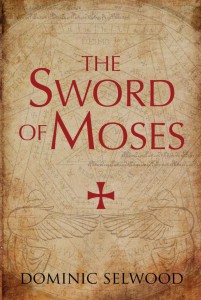I’ve got a lot of time for Dominic Selwood: his 1999 (non-fiction) book Knights of the Cloister: Templars and Hospitallers in Central-Southern Occitania, c.1100-c.1300 painted a detailed, evidence-based picture of the Knights Templars across a properly historical and social background. It is not, as he points out, “light relaxing reading”: but remains a fine counterpoint to the more militaristic / political / conspiratorial accounts of the two Orders, well worth looking at.
Just so you know: back in 2001, I went to a lecture of his at the (now long-slumbering) Canonbury Masonic Research Institute, and later asked him by email about Templar artificial alphabets that were used for signing their proto-‘cheques’. Unfortunately, he replied that “All my notes from my research were thrown away by accident by the staff where I used to work“, (though he may still have some images on slides).
At that time, he had just completed a PhD at Oxford (and occasionally played in a band called The Binmen!) and was then starting the work as a barrister that would occupy him for the next five years: and so I was intrigued to discover a few weeks ago that he had just published a novel called The Sword of Moses (the Kindle version is currently only 62p, which is a steal).
Oddly, this also seems to have necessitated drinking some Johnny Depp-stylee potion, as can be seen from the dramatic physical transformation he has undergone:-
Either that or the novel was written by his evil twin, it’s hard to tell. 😉
Anyway, if you even remotely know how books in the historical-artefact/modern-threat/sassy-hero genre run, you’ll be at home immediately (think Ark of the Covenant, international mercenaries, bombs, assault weapons, etc): and the main character (Dr Ava Curzon) is a kind of passive-aggressive ‘Jane Bond’ / Lara Croft ex-spook-now-sassy-archaeologist hybrid, probably with half an eye towards Angelina Jolie in the film version (as per normal). And if you can find a genuinely empathetic or believable character anywhere in the mix, you’re far more observant than I am: but that’s hardly much of a criticism, as it is industry standard fare for the genre.
The most obviously notable feature, though, is the sheer scale of the book. Not just the chunky page count (792 pages!), but it is very much as though Selwood has collided two or three already biggish novels together, and welded the wreckage together into a fatter, lumpier composite: Ethiopian churches, Iraq, Knights Templar (who, it seems, are still going strong, bless ’em), Masons, MI6, Russian gangsters, Israeli spies, London/Kent Neo-Nazis, necromancy, John Dee, etc all play their respective part (though the Voynich Manuscript only gets a cameo, it has to be said): and even dear old Aleister Crowley gets more than a nod.
Really, this all comes across to me as though Selwood’s Writing Ambition was in a gladiatorial fight to the death against Editorial Control, where only the former was wielding a sword. By which I mean that even though he writes pretty well, whenever his story’s fire starts to flicker a little, he anxiously hurls yet more geopolitics and history onto its flames: but that rich burning smell ultimately comes across as one of insecurity, not of confidence.
For me, though, the most interesting feature of “The Sword of Moses” was the history – the book clearly sits atop the heaped spoils of Selwood’s lifetime’s connoisseurship of alt.history strands. And what I think transforms the whole enterprise into something epic is something that I think emerges from the text only indirectly: his personal micro-crusade against junk history.
Honestly, he seems to be saying, why do novelists invest so much time filling their genre books with historical nonsense, when the real deal is even more excruciatingly complex and intriguing, if you just bother to get your stupid superficial noses out of Wikipedia? And so he goes out of his way to get the history properly right, again and again: mightily impressive, densely entertaining, heavily intertextual stuff.
And so when it comes to the idea that forms the historical backbone of his novel, it’s his idea of a proper shocker: that the Old Testament has polytheism and even ritual sacrifice embedded in it (which is indeed entirely true). But… but… but… this is also where it all goes a bit Pete Tong.
The horrible, dull truth is that exposing the ritualistic layers codicologically embedded in plain sight within The Bible (and having a super-evil necromancer to bring them to some kind of twisted life) just isn’t much of a surprise any more. The Dan Brown sincere flattery crowd (as in “imitation is…”) of novelists have kind of strip-mined the genre: and for all their dodgy historical faults, in the list of their crimes against readers Bad History comes a distant third behind Empty Characterization and Mile-Wide Plot Faults.
So… while I like Dominic and have terrific admiration for his historical sensibilities and indeed writing ambition, I finished his book feeling that he set out on his novel-writing quest to solve the wrong problem. Having myself read far too many books in this genre over recent years than is properly healthy, I’d agree that he really isn’t tilting at windmills – that Bad History is an endemic problem in fiction in general. But he’ll have to work somewhat harder with his next novel to help readers care whether Dr Ava Curzon lives or dies, because frankly I never quite managed that piece of reading magic, sorry. 🙁



Once again I can recommend an antidote to this latest stomach-churning novelization of historic warfare. Robert Lomas and Christopher Knight — The Second Messiah-Templars, The Turin Shroud, and The Secret of Freemasonry. Doctor Lomas backs up their findings and leads you to a chapel in Scotland which, in itself. has a mystery which was only fairly recently solved. Fun! You and your son might enjoy a visit there, after reading the book. I’m hoping Dr. Lomas is still alive and that his Bradford University website is still being maintained.